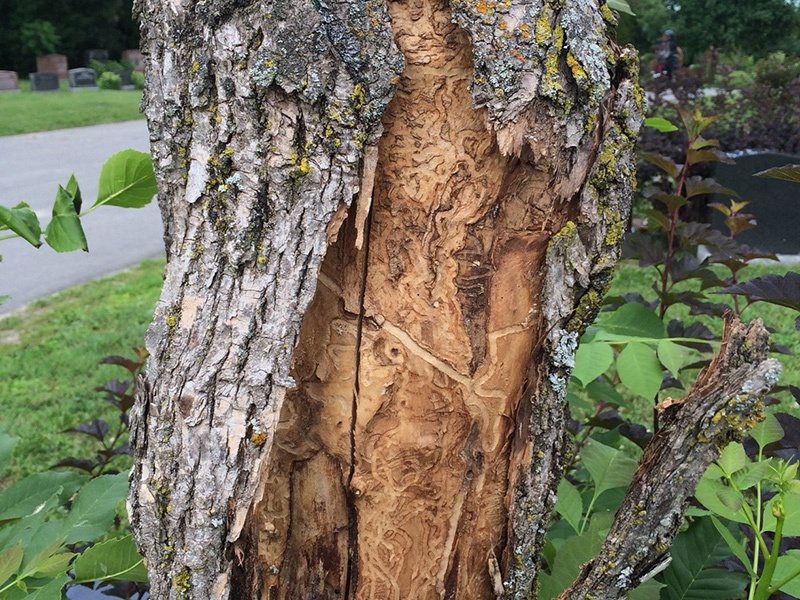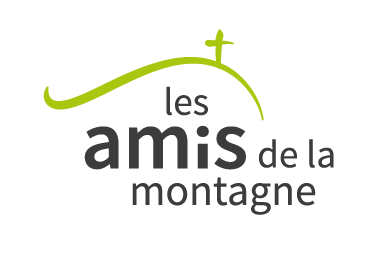The emerald ash borer is an Asian beetle that attacks ash trees in urban and forest areas. This insect pest has greatly affected Mount Royal and its thousands of trees in recent years, with adverse consequences on the territory’s ecosystem. In collaboration with the City of Montréal, Les amis de la montagne is working to stop the devastating spread of this insect in the mountain’s natural environment.

Context
Ash Trees on Mount Royal
Thanks to a series of disturbances that affected Mount Royal’s forest cover—notably the morality cuts in the 1950s and the ice storm of 1998—, ash trees now account for 25 to 30% of the woodlands of Mount Royal Park. Since the 1990s, a large amount of ash trees have also been planted along streets and in parks throughout the Mount Royal territory.
Emerald Ash Borer on Mount Royal: What Is the Situation?
There is much concern over the future of ash trees since the emerald ash borer first appeared in Quebec in 2008 and started to spread. This beetle of Asian origin attacks all species of ash and causes their death within a few years. At the present time, no treatment allows the eradication of this insect from a territory. However, it is possible to slow the spread of the borer and the death of trees by treating a large amount of ash trees, thereby reducing the consequences of their disappearance.
How Does the Emerald Ash Borer Spread?
The borer is a warmth-loving insect that prefers to lay its eggs in ash trees in sunny locations, such as trees along streets or isolated trees on lawns. The majority of efforts in 2016 targeted these locations. The forests of Mount Royal Park, where ash trees benefit from the shade of other trees, were affected later.
Issues
Infestation without Borders
The emerald ash borer causes damage well beyond Mount Royal Park, which only covers 20% of the Mount Royal territory, and also affects thousands of ash trees on private and institutional properties on the mountain.
Impacts on the Mountain’s Natural Environment
Without treatment, the borer will eventually kill most ash trees on the island of Montréal. Ash tree mortality poses a threat to the biodiversity of the Mount Royal territory insofar as it will give rise to gaps in the canopy forming the forest’s upper stratum. These gaps would provide space for many undesirable colonizing species seeking better access to light, which allows them to spread. In order to limit the negative impacts on biodiversity caused by ash tree mortality, it will be essential to proceed with organized tree plantings and control the spread of invasive non-native plants.
Solutions
Working Together Toward a Common Plan
Les amis de la montagne participated with the Table de concertation du mont Royal in networking with major institutional owners (universities, hospitals and cemeteries with Montréal and Westmount public authorities) to ensure that all parties take part in a common plan of action to treat ash trees on their properties and conduct tree felling operations. This plan for the Mount Royal territory was deployed in the summer, and it is hoped that concerted efforts will continue over the next few years.
Treatment to Stop the Spread of the Emerald Ash Borer
The City of Montréal has implemented a yearly annual detection program for the park's ash trees to identify affected trees and monitor the progress of the infestation. Once the presence of borer larvae is detected in an ash, the tree is felled and removed from the premises over the course of the following winter. The City has been treating ash trees in open areas of the park since 2015. As a result, ash trees most vulnerable to infestation are protected using the TreeAzin biopesticide, which prevents the development of borer eggs.
In the summer of 2017, the City also completed a comprehensive inventory of ash trees in Mount Royal Park woodlands. Some 10,193 ash trees measuring over 15 cm in diameter were tallied, of which 6,100 were treated. Nearly 4,000 ash trees, which are either already dead or whose health conditions do not allow treatment, will be felled over the next two years.
The same types of operations—inventory, treatment and felling, planting—will continue on all major institutional properties and cemeteries on the Mount Royal territory over the next few years.
Work will take place in three phases:
- Winter 2018: felling operations in Outremont’s Summit Woods and Tiohtià:ke Otsira’Kéhne Park as well as at the summit of Mount Royal Park.
- Fall 2018 and Winter 2019: felling operations in the Piedmont, Brackenfell (Fougeraie), Beaver Lake Glades and at the Peel entrance to Mount Royal Park.
- 2018 to 2020: reforestation activities in the different sectors.
To compensate for the loss of ash trees and preserve the exceptional quality of Mount Royal's natural environment, the City will plant some 40,000 trees and shrubs by 2020, a ratio of 10 plants for every ash tree cut down. Reforestation is a vital operation that will close gaps caused by felling, prevent space from being taken over by invasive plant species and increase the forest’s overall resilience by increasing tree diversity.
These actions should slow the spread of the borer on the mountain and prevent the massive and sudden death of ash trees. Felling and planting operations will disturb the woodlands and landscaped areas of the mountain, and it will be of the utmost importance to minimize the impacts of such operations on the natural environment, landscapes and users.
Biological Control: An Alternative Solution in Summit Woods
As of today, there are no sustainable solutions to control borer populations. That being said, various research projects are underway in North America, such as using biological control mechanisms by pests or fungi that affect the borer. One of these projects is underway at Summit Woods in Westmount, where parasitic wasps (natural enemies of the borer) are released to reduce insect populations. However, it will take several years before significant results are obtained.
What Is Les amis de la montagne’s Role?
Les amis de la montagne plays a leading role both in the field and with various City and community stakeholders:
- Supporting planting efforts thanks to our Environmental Stewardship Program, which will prioritize the control of invasive plants in the intervention zones.
- Installing signage on site to inform the public of the various operations underway and to advise Mount Royal users on ways to reduce the pressure on soils and limit their degradation.
- Awareness-building and networking with major institutional owners (universities, hospitals and private institutions, including cemeteries) and public authorities (Montréal and Westmount) to develop a joint action plan to preserve the mountain’s forest canopy
- Monitoring past and future actions.
- Taking part in the adoption of better strategies to minimize the impact of the borer on the Mount Royal territory and support the biodiversity of the mountain.
- Raising awareness and mobilizing the community around this issue.
For More Information
If you have an ash tree on your property, read the City of Montréal’s recommendations for identifying and dealing with the emerald ash borer.
Canadian Food Inspection Agency – Information sheet on the emerald ash borer
Natural Resources Canada – Information sheet on research on the emerald ash borer


